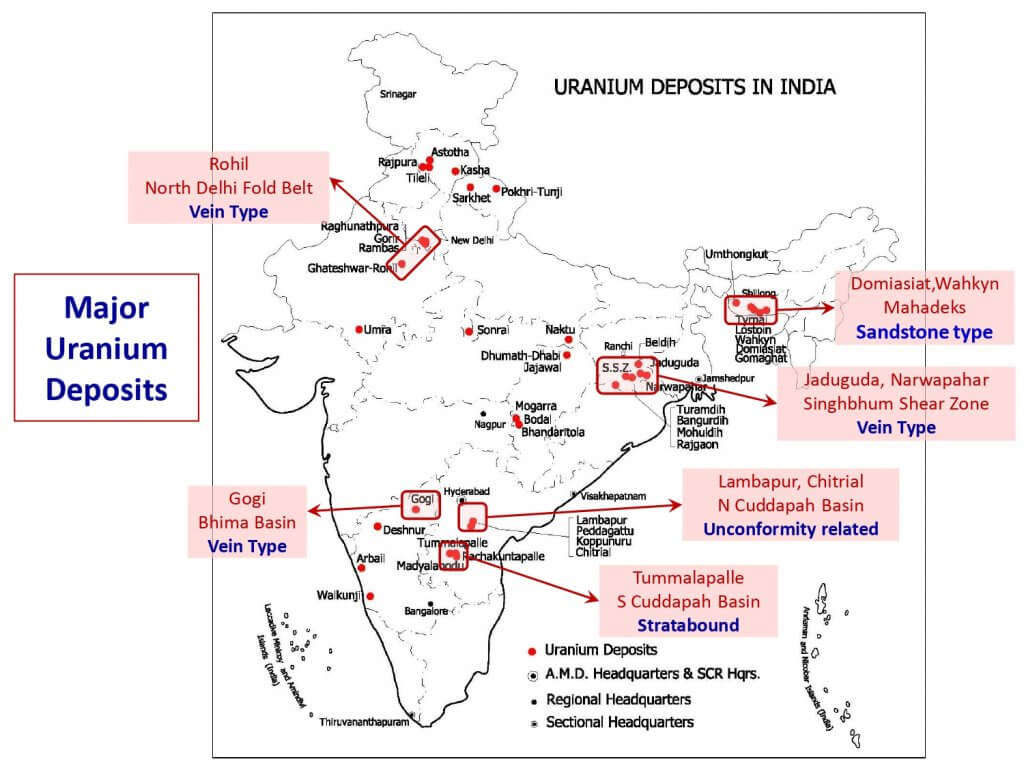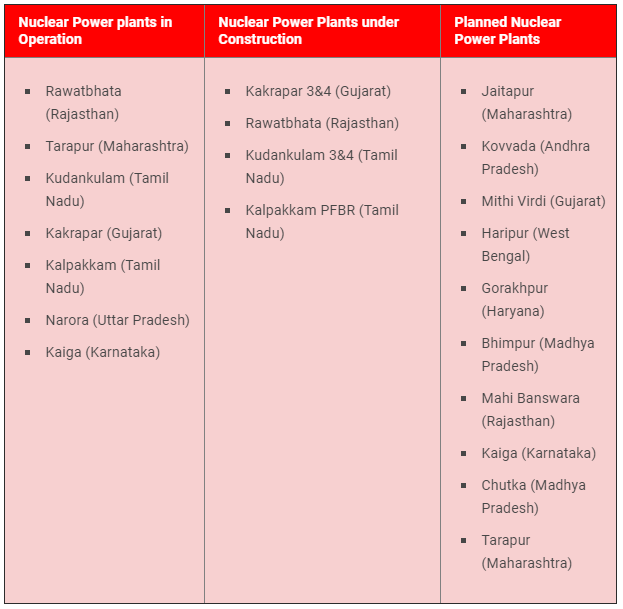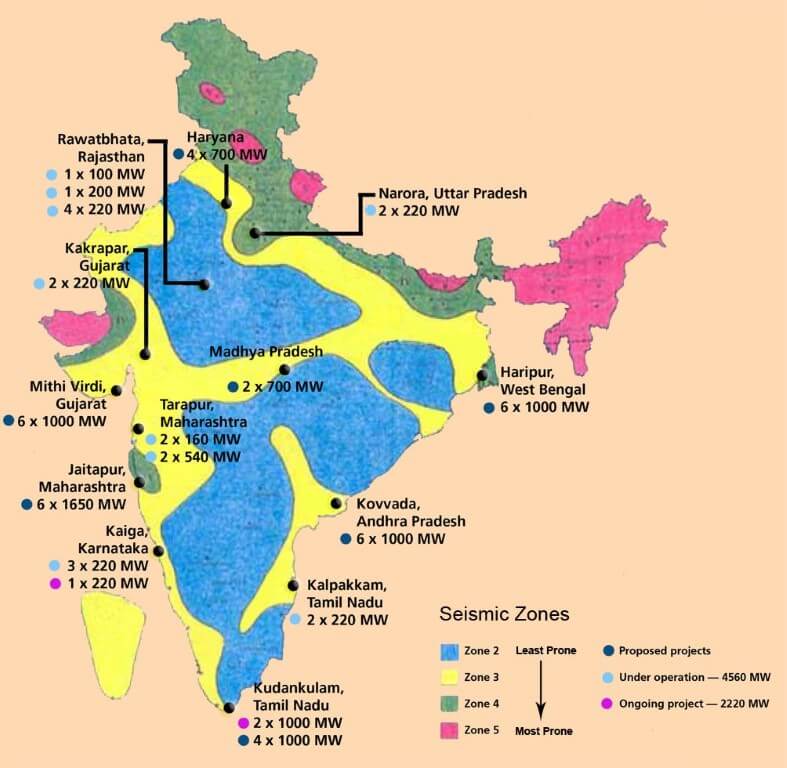In this article, You will read Atomic Minerals & Uranium and Thorium Distribution in India – for UPSC IAS.
Atomic Minerals
- India has huge reserves of Atomic minerals. Uranium and Thorium are the main atomic minerals to which may be added i.e., beryllium, lithium, and zirconium.
- Thorium is derived from monazite which contains 10 percent thoria and 0.3 percent urania. The other mineral carrying thorium is thorianite.
- The nuclear power plants in India use nuclear fuel processed in three stages. The first stage comprises of Uranium which is currently in use in India. The second stage comprises products obtained from processed nuclear fuel while the third stage nuclear fuel comprises of Thorium.
- India has the largest deposits of Thorium in the world and is trying hard to get on to the third stage of nuclear fuel consumption in order to get self-reliant in the nuclear fuel supply.
- India produces about 2 percent of the world’s uranium. The total reserves of uranium are estimated at 30,480 tonnes.
- In India, Uranium deposits occur in Crystalline rocks.
- 70% of Uranium deposits are found in Jharkhand. Uranium deposits occur in the Singhbhum and Hazaribagh districts of Jharkhand, Gaya district of Bihar, and in the sedimentary rocks in the Saharanpur district of Uttar Pradesh.
- Mines of Atomic minerals are given below:


Other minerals having atomic content with economic viability:
- Monazite: Although monazite sands occur on east and west coasts and in some places in Bihar, the largest concentration of monazite sand is on the Kerala coast. Over 15,200 tonnes of uranium is estimated to be contained in monazite.
- Ilmenite: The deposits of Ilmenite occurs in the state of Jharkhand.
- Beryllium: Beryllium oxide is used as a ‘moderator’ in nuclear reactors for atomic power generation. India has sufficient reserves of beryllium to meet its requirement of atomic power generation. It is found in the states of Rajasthan, Jharkhand, Andhra Pradesh, and Tamil Nadu.
- Zirconium: Zirconium is found along the Kerala coast and in alluvial rocks of Ranchi and Hazaribagh districts of Jharkhand.
- Lithium: Lithium is a light metal which is found in lepidolite and spodumene. Lepidolite is widely distributed in the mica belts of Jharkhand, Madhya Pradesh, and Rajasthan as well as in the Bastar region of Chhattisgarh.
Five centers of Atomic energy in India are:
- Tarapur Nuclear Reactor: The Tarapur Nuclear Reactor in Maharashtra, Western India is the oldest nuclear facility in India, having commenced commercial operations in 1969.
- Rana Pratap Sagar Plant (Rajasthan) – It is located in Kota Industrial Complex and eastern Rajasthan.
- Narora Nuclear Reactor: The Narora Nuclear Reactor in Uttar Pradesh, Northern India has two PHWR which offer a total capacity of 440MW. Unit 1 was installed in January 1991, and unit 2 following in July 1992.
- Kalapakkam Nuclear Power Plant: Kalapakkam Nuclear Power Plant in Tamil Nadu first began operating in 1984 and currently has two 235MW reactors, with two more reactors of 500MW and 600MW to be added at a later date.
- Kakarapar Atomic Power Plant: The Kakarapar Atomic Power Plant in Gujarat, Western India has two PHWR reactors with a total installed capacity of 440MW. The two reactors were completed in May 1993 and September 1995 respectively.
By 2020, India has planned to increase its energy production from nuclear power plants to 20,000 MW.


Uranium
- Uranium is a silvery-gray metallic radioactive chemical element. It is only naturally formed in supernova explosions.
- Uranium, thorium, and potassium are the main elements contributing to natural terrestrial radioactivity.
- Uranium has the chemical symbol U and atomic number 92.
- Uranium isotopes in natural uranium are 238U (99.27%) and 235U (0.72%).
- All uranium isotopes are radioactive and fissionable. But the only 235U is fissile (will support a neutron-mediated chain reaction).
- Traces of Uranium are found everywhere. Commercial extraction is possible only in locations where the proportion of Uranium is adequate. There are very few such locations.
Distribution of Uranium Across the World
- The largest viable deposits are found in Australia, Kazakhstan, and Canada.
- Olympic Dam and the Ranger mine in Southern Australia are important mines in Australia.
- High-grade deposits are only found in the Athabasca Basin region of Canada.
- Cigar Lake, McArthur River basin in Canada are other important uranium mining sites.
- The Chu-Sarysu basin in central Kazakhstan alone accounts for over half of the country’s known uranium resources.
- Kazakhstan produces the largest share of uranium from mines (42% of world supply from mines in 2019), followed by Canada (13%) and Australia (12%).
Uranium in India
- India has no significant reserves of Uranium. All needs are met through imports.
- India imports thousands of tonnes of uranium from Russia, Kazakhstan, France, and
- India is trying hard to import uranium from Australia and Canada. There are some concerns regarding nuclear proliferation and other related issues which India is trying to sort out.
- Some quality reserves were recently discovered in parts of Andhra Pradesh and Telangana between Seshachalam forest and Sresailam (Southern edge of Andhra to Southern edge of Telangana).
Uranium Mines
- Jharkhand
- Jaduguda, Bhatin, Narwapahar, Bagjata, Turamdih, Banduhurang, Mohuldih
- Meghalaya
- Kylleng, Pyndeng-Shahiong (Domiasiat), Mawthabah, Wakhym
- Andhra Pradesh
- Lambapur-Peddagattu, Tummalapalle
- Jadugora
- Located in the Singhbhum district of Jharkhand
- The first uranium mine opened by UCIL in 1968
- Ores are treated in a mill located a Jaduguda itself
- UCIL is located here itself
- Tummalapalle
- It is located in the YSR district of Andhra Pradesh.
- The combined reserve in 49000 tonnes of uranium. It can be increased three times, which will make it the mine with the largest uranium deposits in the world.
- Mohuldih
- It is located in the Seraikella – Kharsawan district of Jharkhand.
- It was commissioned by UCIL on 17 April 2012.
- The ore produced here were be sent to Turamdih Processing Plant.
- Turamdih
- It is located in the East Singhbhun district of Jharkhand.
- It has 7.6 million tonnes of uranium are reserves.
- A new uranium procession plant has been constructed here.
Thorium
- Thorium is a chemical element with the symbol Th and the atomic number 90.
- It is one of only two significantly radioactive elements that still occur naturally in large quantities (the other being uranium).
- Thorium metal is silvery and tarnishes black when exposed to air.
- Thorium is weakly radioactive: all its known isotopes are unstable, with the seven naturally occurring ones (thorium-227, 228, 229, 230, 231, 232, and 234).
- Thorium-232 is the most stable isotope of thorium and accounts for nearly all natural thorium, with the other five natural isotopes occurring only in traces.
- Thorium is estimated to be about three to four times more abundant than uranium in the Earth’s crust and is chiefly refined from monazite sands [Monazite contains 2.5% thorium][Monazite is a widely scattered on the Kerala Coast].
- Thorium is predicted to be able to replace uranium as nuclear fuel in nuclear reactors, but only a few thorium reactors have yet been completed.
Monazite – Rare Earth Metals
- Monazite is a reddish-brown phosphate mineral containing rare earth metals.
- Rare earths are a series of chemical elements found in the Earth’s crust that are vital to many modern technologies, including consumer electronics, computers and networks, communications, clean energy, advanced transportation, health care, environmental mitigation, national defense, and many others.
- Because of their unique magnetic, luminescent, and electrochemical properties, these elements help make many technologies perform with reduced weight, reduced emissions, and energy consumption; or give them greater efficiency, performance, miniaturization, speed, durability, and thermal stability.
- There are 17 elements that are considered to be rare earth elements, specifically the fifteen lanthanides plus scandium and yttrium.
Advantages of Thorium
- Proliferation is not easy: Weapons-grade fissionable material (U-233) is harder to retrieve safely from a thorium reactor [U-233 produced by transmuting thorium also contains U-232, a strong source of gamma radiation that makes it difficult to work with. Its daughter product, thallium-208, is equally difficult to handle and easy to detect].
- Thorium reactors produce far less waste than present-day reactors.
- Thorium produces 10 to 10,000 times less long-lived radioactive waste.
- They have the ability to burn up most of the highly radioactive and long-lasting minor actinides that make nuclear waste from Light Water Reactors a nuisance to deal with.
- Thorium reactors are cheaper because they have higher burn-up.
- Thorium mining produces a single pure isotope, whereas the mixture of natural uranium isotopes must be enriched to function in most common reactor designs.
- Thorium cannot sustain a nuclear chain reaction without priming, so fission stops by default in an accelerator-driven reactor.


Thanks for providing valuable meterials.
thanks.. i ill pay for this material